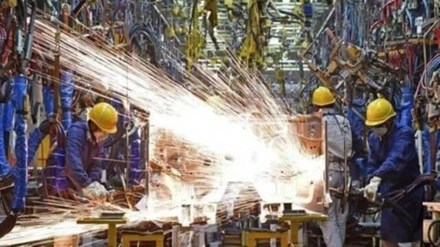The index of industrial production grew 5.6% in February 2023 as the manufacturing sector picked up pace and electricity generation remained buoyant, even as a favourable base helped too.
The index had risen by 5.45% in January (revised) and was at a mere 1.2% in February 2022. On a cumulative basis, the index grew 5.5% between April 2022 and February 2023, which is lower than the 12.5% growth in the first 11 months of 2021-22. Prior to this, the IIP grew at a high of 7.3% in November 2022.
While the February print marks a four-month high and was higher than anticipated, there are questions on whether the momentum would sustain in coming months as high inflation bites into demand and external headwinds blow.
The headline figure was largely supported by a very low base, as output declined a considerable 5.6% month on month, compared with 1.1% growth in January. The sequential decline was broad-based across sectors, said Rahul Bajoria, MD and head of EM Asia (ex-China) Economics, Barclays.
Icra expects the year-on-year growth in the IIP to dip to about 3-4% in March 2023.
India Ratings and Research believes that despite encouraging signs a broad based and sustainable industrial recovery is some distance away and will require both fiscal and monetary policy support, said its economists Sunil Sinha and Paras Jasrai.
According to the official data released on Wednesday, the manufacturing sector grew by 5.3% y-o-y basis in February compared to 4% in January. However, the growth in both mining and electricity generation at 4.6% and 8.2%, respectively, in February was lower than January levels when they expanded by 8.8% and 12.7%, respectively. Electricity generation grew at less than double digits for the first time in four months.
Amongst use based classification of goods, four of the six sectors, barring intermediate goods and consumer durables, registered positive growth in February. With the government’s focus on infrastructure investments, capital goods grew by 10.5% in February 2022 as against a mere 1.3% a year ago. Infrastructure goods also grew by a robust 7.9% in the month while primary goods expanded by 6.8%. However, intermediate goods contracted by 0.3%.
More disappointing was the continued contraction in consumer durables for the third month in a row. Durables’ output shrank 4% in February, even as consumer non-durables posted a 12.1% growth.
“The use-based classification shows that durable consumer goods disappoint with -4% de-growth that comes on negative growth of 9.7% last year. High inflation is a reason that has come in the way of demand, said Madan Sabnavis, chief economist, Bank of Baroda, while noting that FMCG had recovered in February 2023 against a negative base last year.
Private consumption demand is expected to slow down in coming months due to the impact of the successive rate hikes as well as waning pent-up demand. However, a favourable monsoon could give some boost to rural demand.
Export related sectors also continued to face the brunt of the global slowdown.
Sectors including textiles (-9.8%), apparels ( -17%) and leather (-6.7%) registered contraction in February. In all, 11 of the sectors registered negative growth in February although at a slower pace compared to January. These sectors included tobacco (-2.5%) computer, electronics and optical products (-11.9%), and wood and products of wood and cork (-14.1%).
Within manufacturing, some of the main drivers of growth were chemicals (7.7%), non-metallic minerals (3%), basic metals (5.4%) and motor vehicles, trailers and semi-trailers (8.2%).
Bajoria noted that sequentially, manufacturing was down 5.5% month on month. “The slowdown in manufacturing was particularly prominent in export-oriented sectors. This is corroborated by capital goods imports data, which showed continued expansion in February in year-on-year terms, albeit at a slower pace, he said.
